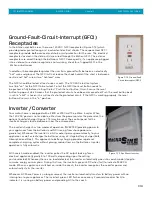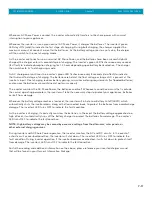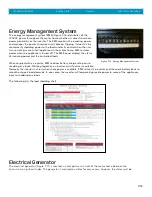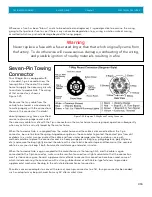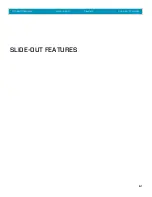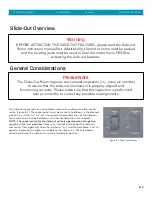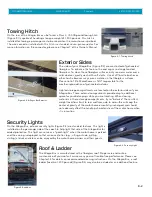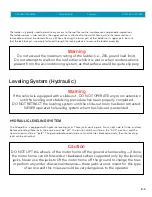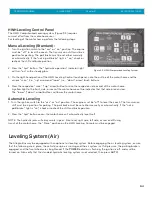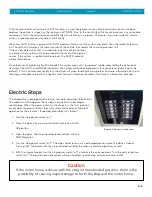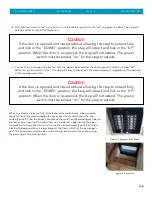
TIFFIN MOTORHOMES
–ALLEGRO BUS®
Chapter 7
ELECTRICAL FEATURES
Ground-Fault-Circuit-Interrupt (GFCI)
Receptacles
In the kitchen and bath areas, there are 120 VAC GFCI receptacles (Figure 7-14) which
provide greater protection against inadvertent electrical shocks. These specialized GFCI
receptacles provide both overload and short-circuit protection for the user. The electrical
receptacles located in the slide-out(s) are wired through the kitchen GFCI. The exterior
receptacles are wired through the bathroom GFCI. Consequently, if an appliance plugged
into a slide-out or exterior receptacle is not working, check for a tripped GFCI in the
kitchen or bathroom.
In addition, these receptacles protect the user from ground faults between an electrically
“hot” wire and ground. The GFCI will not reduce the shock hazard if the short is between a
neutral and “hot” wire or two “hot-lead” wires.
The GFCI should be tested at least once a month. The 120 VAC electrical system
must be “on” for the GFCI to be tested. To test the GFCI the reset button needs to
be pushed in fully before starting the test. Push the test button; this will cause the reset
button to pop out which means that the protected circuits have been disconnected. Push the reset button back
in until a “click” is heard—this will reactivate the protected circuit. If the GFCI is working properly, the reset
button will remain in the “in” position.
Inverter / Converter
Your motor home is equipped with a 2800 or 2000 watt Sine Wave Inverter. When
the 120 VAC power is not available, either from the power cord or the generator, the
optional inverter/charger (Figure 7-15) may be used. The control panel for the
inverter/charger is located above or near the entrance door.
The inverter/charger has two modes of operation: INVERTER (providing power to
your appliances from the batteries) and AC (running from shore power or a
generator). Whenever the inverter is in AC mode, it passes power directly to your
appliances as well as recharges the batteries using a 3-stage battery charger (Bulk,
Absorption and Float). This approach to battery charging provides rapid and
complete chargining cycles without placing undue stress on the batteries. Inverter
operation is fully automatic.
With search mode enabled, the inverter pulses the AC output looking for an
electrical appliance (typically 5 to 100 watts, depending upon the setting
you’ve selected). Whenever there is no load detected, the inverter automatically goes into search mode (sleep) to
minimize energy consumption. During this time, the inverter’s green LED flashes (fast) to indicate SEARCH
mode. When an appliance is switched on inside the coach, the inverter recognizes the need for power and
automatically starts the inverter.
Whenever AC Shore Power is no longer sensed, the inverter automatically transfers to battery power with no
interruption to your appliances. The inverter’s green LED flashes once every 2 seconds (medium flash) to
indicate it is running on battery power and providing AC to the coach.
7-10
Figure 7-14. Ground-Fault
Circuit Interrupter (GFCI)
Figure 7-15. Sine Waver Inverter
Summary of Contents for 2014 Allegro Bus
Page 6: ... TIFFIN MOTORHOMES ALLEGRO BUS Chapter 1 GENERAL INFORMATION GENERAL INFORMATION 1 1 ...
Page 51: ... TIFFIN MOTORHOMES ALLEGRO BUS Chapter 5 CABINETS FURNITURE CABINETS FURNITURE 5 1 ...
Page 55: ... TIFFIN MOTORHOMES ALLEGRO BUS Chapter 6 STRUCTURAL FEATURES STRUCTURAL FEATURES 6 1 ...
Page 57: ... TIFFIN MOTORHOMES ALLEGRO BUS Chapter 7 ELECTRICAL FEATURES ELECTRICAL FEATURES 7 1 ...
Page 72: ... TIFFIN MOTORHOMES ALLEGRO BUS Chapter 8 SLIDE OUT FEATURES SLIDE OUT FEATURES 8 1 ...
Page 76: ... TIFFIN MOTORHOMES ALLEGRO BUS Chapter 9 EXTERIOR FEATURES EXTERIOR FEATURES 9 1 ...
Page 83: ... TIFFIN MOTORHOMES ALLEGRO BUS Chapter 10 INTERIOR FEATURES INTERIOR FEATURES 10 1 ...
Page 87: ... TIFFIN MOTORHOMES ALLEGRO BUS Chapter 11 PLUMBING BATH FIXTURES PLUMBING BATH FIXTURES 11 1 ...
Page 105: ... TIFFIN MOTORHOMES ALLEGRO BUS Chapter 13 ROUTINE MAINTENANCE ROUTINE MAINTENANCE 13 1 ...















